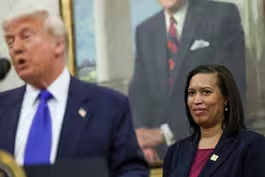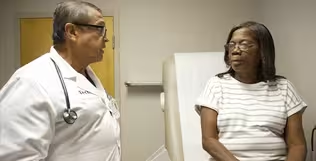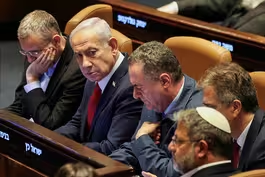
As tariffs kick in, economist flags recession warning signs
Clip: 8/7/2025 | 5m 44sVideo has Closed Captions
As Trump's tariffs kick in, economist breaks down inflation and recession warning signs
After months of delay and backroom dealmaking, the Trump administration has imposed sweeping tariffs on nearly 100 countries, sending U.S. import duties soaring to their highest levels in nearly a century. To help break down the impact of the new tariffs and interpret some signs we’re seeing across the economy, Geoff Bennett spoke with Diane Swonk, chief economist at KPMG.
Problems playing video? | Closed Captioning Feedback
Problems playing video? | Closed Captioning Feedback
Major corporate funding for the PBS News Hour is provided by BDO, BNSF, Consumer Cellular, American Cruise Lines, and Raymond James. Funding for the PBS NewsHour Weekend is provided by...

As tariffs kick in, economist flags recession warning signs
Clip: 8/7/2025 | 5m 44sVideo has Closed Captions
After months of delay and backroom dealmaking, the Trump administration has imposed sweeping tariffs on nearly 100 countries, sending U.S. import duties soaring to their highest levels in nearly a century. To help break down the impact of the new tariffs and interpret some signs we’re seeing across the economy, Geoff Bennett spoke with Diane Swonk, chief economist at KPMG.
Problems playing video? | Closed Captioning Feedback
How to Watch PBS News Hour
PBS News Hour is available to stream on pbs.org and the free PBS App, available on iPhone, Apple TV, Android TV, Android smartphones, Amazon Fire TV, Amazon Fire Tablet, Roku, Samsung Smart TV, and Vizio.
Providing Support for PBS.org
Learn Moreabout PBS online sponsorshipGEOFF BENNETT: Welcome to the "News Hour."
After months of delay and back room dealmaking,# the Trump administrati.. tariffs on nearly 100 countries, sending U.S.# import duties soaring to their highest levels## in nearly a century.
The new rates range# from 10 to 15 percent for Japan, the E.U.,## and the U.K. that negotiated agreements# and as high as 50 percent on nations such## as Brazil and India.
India's tariffs are# scheduled to take effect in three weeks.
Meantime, many countries continue to work behind# the scenes to negotiate more favorable deals.
To help break down the impact of the# new tariffs and interpret some of the## other signs we're seeing across the# economy, we're joined again by Diane## Swonk.
She's chief economist at KPMG.
That's# the global consulting and accounting firm.
Diane, it's always great to see you.
So the Yale Budget Lab ran the numbers# and found that the average effective## tariff rate is now about 18 percent.# That's the highest it's been since 1933.## Put that into perspective for us.
What does# that mean for the U.S. economy overall?
DIANE SWONK, Chief Economist, KPMG: Well,# what's really important is that tariffs tend## to be -- historically, they're a one and done, a# bump-up and a one time increase in price levels.
But this doubling of tariffs, basically# doubling from what we saw in June,## the effective tariff rate, that is not only# going to add to another increase in prices,## which we're only beginning to see the early signs# of right now, but also the tariffs are so large## that they also squeeze profit margins# and that means cost-cutting or layoffs.
And so what we're worried about is a sort# of stagflationary kind of nature of these## tariffs because they're so large and they're# just unable to be completely absorbed by## either firms themselves or completely# passed on to consumers 100 percent.
We're looking for inflation to pick up# to about 3.5 percent by year-end and## then stay elevated a little bit longer# than we initially expected because of## the sequential nature of these tariffs# and the fact that we have had inflation## running above the Fed's target for the# better part of more than four years.
And that's important as well# because it makes the risk of a## more persistent bout of inflation# much higher at the same time that## we're seeing the labor market start to# show some fault lines and stagnating.
GEOFF BENNETT: You wrote today that# tariffs are now fueling inflation,## causing lethargy in the labor market and# further sowing the seeds of uncertainty.## You also said it's possible that we could# be in a recession and not even know it.
What suggests to you that we're# inching our way toward a recession?
DIANE SWONK: Well, we still have# a 40 percent chance of recession.## And we aren't forecasting a full recession yet.
But the key issue is that we're looking at# not -- every recession is different.
However,## we have never seen the share of the# long-term unemployed -- those are## people unemployed more than 27 weeks,# which also their length of unemployment## went up in the month of July.
The share of# the total labor force, that has picked up.
That usually happens after a# recession is already under way.## We saw in 2008 the U.S. economy actually# entered the recession in January of 2008,## even though the global financial crisis# and the realization that we were in a## very severe recession, the Great Recession,# didn't occur until September of that year.
GEOFF BENNETT: So with a stagnating job# market, inflation threatening to heat up,## that really makes a complicated# decision matrix for the Fed.
The## Fed's going to make their decision# about the next rate cut in September.
What are the challenges that they're# facing and what are you forecasting?
DIANE SWONK: Well, it's really a toxic situation# for the Federal Reserve.
They do want to preserve## the economy.
And we have got this very narrow# margin of error in the labor market where,## frankly, 50,000 to 80,000 jobs is all we need# each month to keep the unemployment rate stable.
But that also means that anything lower than that,# which we could get with some of the cuts that are## already in the pipeline, that would be an increase# in the unemployment rate.
So they're talking about## higher inflation and higher unemployment.# That's a very hard situation to be in.
And what we expect is, the Fed will cut two times# by the end of the year in October and December.## So, September is a hard and heavy lift,# given we think the inflation numbers are## going to get worse faster than the# employment numbers initially.
But,## still, this is a very difficult# situation for the Federal Reserve.
GEOFF BENNETT: I want to ask you about# an announcement that President Trump## made late today.
He announced that# he was nominating Stephen Miran to## fill a vacant seat on the Fed's# seven-member Board of Governors.
The president said that Miran would# serve through January of next year## while he continued to search for# a permanent replacement.
What## should we know about him and how does his# presence change the dynamic on the board?
DIANE SWONK: Well, I think it's really# unusual that we're only having sort of## a short-term appointment, which means it# means less for perceptions of the Fed.
And,## obviously, the president wants to# figure out who he thinks will be## best to replace Chairman Powell or who# he favors to replace Chairman Powell.
But this sort of placeholder kind of placement# means that we're not going to be -- the markets,## financial markets will not be watching# as much how this person votes.
I would## expect him to dissent even as the Fed cuts# because the president has made clear that he## does want more cuts than currently the Fed is# even pondering.
And I think that's important.
GEOFF BENNETT: Diane Swonk,# chief economist at KPMG,## thanks again for joining us.
We appreciate it.
DIANE SWONK: Thank you.
A Brief But Spectacular take on intergenerational community
Video has Closed Captions
Clip: 8/7/2025 | 4m 3s | A Brief But Spectacular take on the power of intergenerational communities (4m 3s)
GOP Rep. Lawler calls for redistricting battles to end
Video has Closed Captions
Clip: 8/7/2025 | 5m 55s | 'Mutually assured destruction': GOP Rep. Lawler calls for redistricting battles to end (5m 55s)
A look at Trump's legal power as he threatens DC takeover
Video has Closed Captions
Clip: 8/7/2025 | 6m 3s | A look at Trump's legal authority over DC as he threatens federal takeover (6m 3s)
Medicaid reliance places Louisiana on frontlines of cuts
Video has Closed Captions
Clip: 8/7/2025 | 5m 23s | Louisiana’s high Medicaid reliance places state on frontlines of health care cuts (5m 23s)
Mideast experts analyze risks as Israel considers occupation
Video has Closed Captions
Clip: 8/7/2025 | 9m 46s | Mideast experts analyze consequences as Israel considers full Gaza occupation (9m 46s)
New book 'Joy Goddess' reveals A’Lelia Walker's influence
Video has Closed Captions
Clip: 8/7/2025 | 8m 37s | New book 'Joy Goddess' reveals how A’Lelia Walker helped shape the Harlem Renaissance (8m 37s)
News Wrap: Netanyahu aims to reoccupy all of Gaza militarily
Video has Closed Captions
Clip: 8/7/2025 | 7m | News Wrap: Netanyahu says Israel aims to reoccupy all of Gaza militarily (7m)
Providing Support for PBS.org
Learn Moreabout PBS online sponsorshipSupport for PBS provided by:
Major corporate funding for the PBS News Hour is provided by BDO, BNSF, Consumer Cellular, American Cruise Lines, and Raymond James. Funding for the PBS NewsHour Weekend is provided by...


















